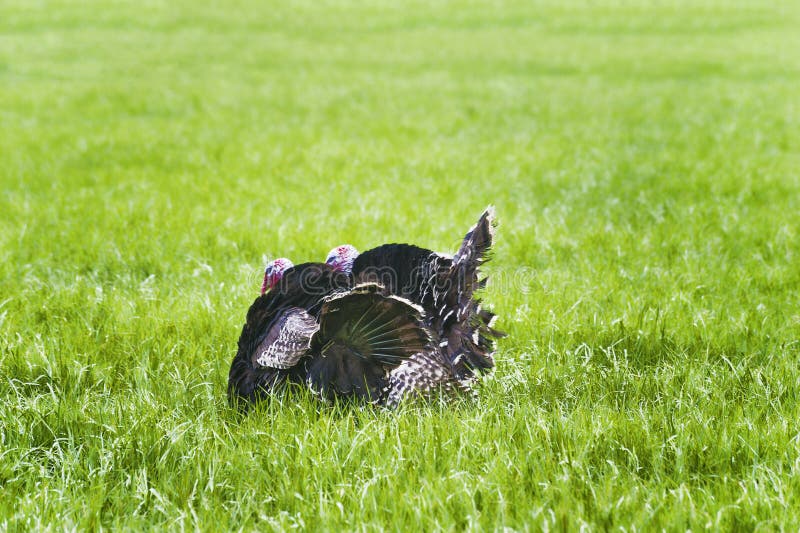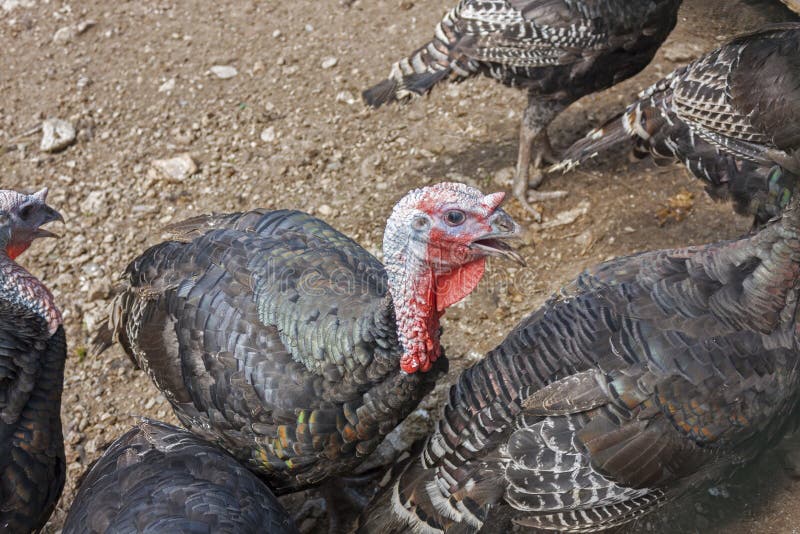Domesticated turkeys have become an integral part of our culinary traditions, particularly during Thanksgiving and other festive occasions. These birds, descendants of wild turkeys native to North America, have been selectively bred over centuries to meet human needs. Their journey from the wild to domestication is a story of adaptation, evolution, and human intervention.
While domesticated turkeys are often associated with large family gatherings and festive meals, their significance goes beyond the dinner table. Understanding their history, characteristics, and role in agriculture provides valuable insights into how humans have shaped the species over time. This article will delve into the world of domesticated turkeys, exploring their origins, breeding practices, and the importance they hold in modern society.
As we continue to rely on domesticated turkeys for food production, it becomes essential to explore sustainable practices and ethical considerations surrounding their farming. By understanding their biology and behavior, we can better appreciate these remarkable birds and ensure their welfare in agricultural settings.
Read also:Pablo Escobars Parents The Influential Figures Behind The Infamous Drug Lord
Domestication History of Turkeys
The domestication of turkeys dates back thousands of years, with evidence suggesting that Native American tribes in present-day Mexico were among the first to domesticate these birds. Archaeological findings indicate that turkeys were domesticated as early as 800 BCE, primarily for their feathers and later for their meat. The Aztecs and other Mesoamerican civilizations played a crucial role in shaping the early domestication process.
Origins of Domesticated Turkeys
Wild turkeys (Meleagris gallopavo) were the ancestors of today's domesticated turkeys. These birds were native to the forests of North America and were known for their impressive size and vibrant plumage. Over time, selective breeding led to the development of distinct breeds, each tailored to specific purposes such as meat production or ornamental value.
Key points about the origins of domesticated turkeys include:
- Domestication began in Mesoamerica around 800 BCE.
- Native American tribes initially domesticated turkeys for their feathers.
- European explorers later introduced domesticated turkeys to Europe in the 16th century.
Characteristics of Domesticated Turkeys
Domesticated turkeys differ significantly from their wild counterparts in terms of physical traits, behavior, and genetic makeup. Through generations of selective breeding, these birds have developed characteristics that make them ideal for agricultural purposes. Understanding these differences is crucial for anyone interested in raising or studying domesticated turkeys.
Physical Traits of Domesticated Turkeys
Domesticated turkeys are generally larger and heavier than wild turkeys, with some breeds reaching weights of up to 40 pounds (18 kg). Their white or bronze feathers are often more uniform in color compared to the iridescent plumage of wild turkeys. Additionally, domesticated turkeys have been bred to have shorter wings and legs, making them less capable of flying compared to their wild relatives.
Key physical traits of domesticated turkeys include:
Read also:Discover The Hidden Gem Of Berthoud Falls Cascades
- Large body size, with some breeds weighing up to 40 pounds.
- Uniform white or bronze feathers.
- Shorter wings and legs, limiting their ability to fly.
Breeds of Domesticated Turkeys
Over the centuries, farmers and breeders have developed numerous turkey breeds, each with unique characteristics suited to specific purposes. While some breeds are primarily raised for their meat, others are kept for their ornamental value or historical significance. Understanding the diversity of turkey breeds can help farmers make informed decisions about which breed to raise.
Popular Turkey Breeds
Some of the most popular domesticated turkey breeds include:
- Broad-Breasted White: The most commonly raised breed for commercial meat production.
- Narragansett: A heritage breed known for its hardiness and adaptability.
- Bronze: A breed prized for its striking plumage and meat quality.
- Beltsville Small White: A smaller breed suitable for backyard farming.
Each breed has its own advantages and challenges, making it important for farmers to choose the right breed based on their goals and resources.
Nutritional Value of Turkey Meat
Domesticated turkeys are not only a cultural symbol but also a valuable source of nutrition. Turkey meat is rich in protein, low in fat, and packed with essential vitamins and minerals. Its nutritional profile makes it a popular choice for health-conscious consumers and those looking to maintain a balanced diet.
Health Benefits of Turkey Meat
Consuming turkey meat offers several health benefits, including:
- High protein content, supporting muscle growth and repair.
- Low fat content, making it an ideal choice for weight management.
- Rich in vitamins B6 and B12, which support brain function and energy production.
- Contains minerals such as selenium and zinc, boosting immune system health.
These nutritional benefits have contributed to the widespread popularity of turkey meat in various cuisines around the world.
Commercial Farming Practices
The commercial farming of domesticated turkeys is a highly specialized industry that involves advanced techniques and technologies. From hatcheries to processing plants, each stage of turkey farming is designed to maximize efficiency and ensure the welfare of the birds. However, the industry also faces challenges related to sustainability and ethical concerns.
Key Aspects of Turkey Farming
Important aspects of commercial turkey farming include:
- Selective breeding to improve growth rates and meat quality.
- Controlled environments to optimize health and productivity.
- Feeding programs tailored to meet the nutritional needs of turkeys.
- Implementing welfare standards to ensure humane treatment of birds.
By addressing these aspects, farmers can produce high-quality turkey meat while minimizing environmental impact.
Conservation and Ethical Considerations
While domesticated turkeys have been successfully integrated into agricultural systems, their wild counterparts face threats from habitat loss and climate change. Conservation efforts are essential to protect wild turkey populations and maintain biodiversity. Additionally, ethical considerations surrounding the treatment of domesticated turkeys have gained attention in recent years, prompting discussions about humane farming practices.
Challenges in Turkey Conservation
Some of the challenges in conserving wild turkeys include:
- Habitat fragmentation due to urbanization and agriculture.
- Climate change affecting food availability and breeding patterns.
- Predation by invasive species and natural predators.
Addressing these challenges requires collaboration between conservationists, farmers, and policymakers to ensure the long-term survival of both wild and domesticated turkeys.
Cultural Significance of Domesticated Turkeys
Domesticated turkeys hold a special place in the cultural fabric of many societies, particularly in North America. Their association with Thanksgiving and other holidays has made them a symbol of gratitude and togetherness. Beyond their role in culinary traditions, turkeys also feature prominently in art, literature, and folklore, reflecting their deep-rooted connection to human culture.
Turkeys in Popular Culture
Turkeys have been depicted in various forms of media, including:
- Films and television shows featuring anthropomorphic turkeys.
- Literary works exploring the relationship between humans and turkeys.
- Artistic representations of turkeys in paintings and sculptures.
These cultural references highlight the enduring appeal of domesticated turkeys and their significance in human society.
Future of Domesticated Turkeys
As the global population continues to grow, the demand for turkey meat is expected to increase, presenting both opportunities and challenges for the industry. Advances in genetic research, farming technology, and sustainable practices may help meet this demand while addressing environmental and ethical concerns. The future of domesticated turkeys lies in balancing productivity with conservation and welfare.
Innovations in Turkey Farming
Emerging innovations in turkey farming include:
- Genetic engineering to enhance disease resistance and growth efficiency.
- Smart farming technologies to monitor and optimize bird health.
- Sustainable practices to reduce the environmental footprint of turkey farming.
By embracing these innovations, the industry can ensure the long-term viability of domesticated turkeys while promoting their welfare and conservation.
Conclusion
Domesticated turkeys have come a long way since their early domestication by Native American tribes. From their origins in the wild to their current role in agriculture and culture, these birds have played a significant part in shaping human history. Understanding their biology, behavior, and cultural significance can help us appreciate their value and ensure their sustainable future.
We invite you to share your thoughts and experiences with domesticated turkeys in the comments below. Whether you're a farmer, a chef, or simply a turkey enthusiast, your insights can contribute to a deeper understanding of these remarkable birds. Don't forget to explore other articles on our site for more information about agriculture, food production, and sustainable practices.
Table of Contents
- Domestication History of Turkeys
- Characteristics of Domesticated Turkeys
- Breeds of Domesticated Turkeys
- Nutritional Value of Turkey Meat
- Commercial Farming Practices
- Conservation and Ethical Considerations
- Cultural Significance of Domesticated Turkeys
- Future of Domesticated Turkeys
- Conclusion


